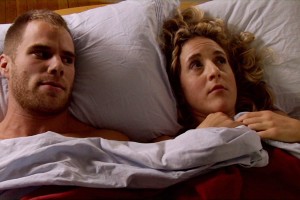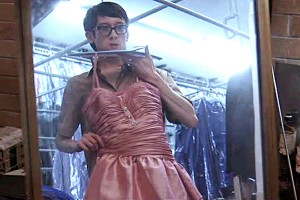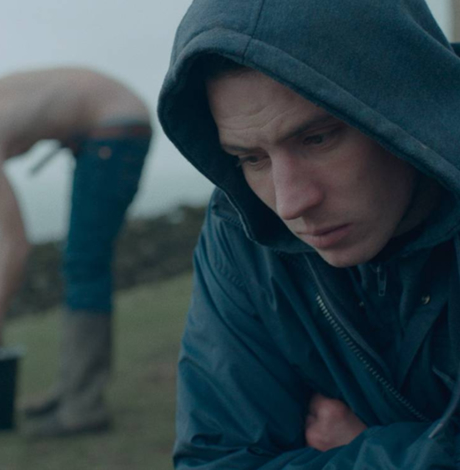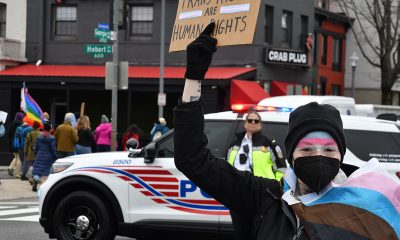Movies
Succinct cinema
Theatrical bon mots abound at this weekend’s shorts festival
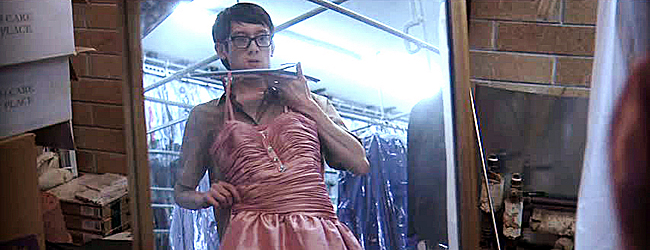
Editor’s note — “Today” in this article refers to Friday, Jan. 28, the Blade’s “street date.”
‘Rewind: The Best of DC Shorts’
7 and 9:30 p.m. in Theatre 1
7:30 and 10 p.m. in Theatre 2
Today and SaturdayFilms are also shown on Saturday beginning at noon
including a free show of animation, comedy and drama
at noon for families and kids over 8.Atlas Performing Arts Center
1333 H St. N.E.$50 all-access pass for all screening
or $12 per show. Available online
at rewind.dcshorts.com/tickets
or at the Atlas box office.The “Celebrating Diversity” block of LGBT films is at 7:30 tonight in Theatre 2,
while other blocks, including films defined as local, foreign, comedy, and
documentary, are at different times — see website for details.
The long and the short of it is that no one can really agree on what’s a film short.
The Academy of Motion Picture Arts and Sciences, annual purveyor of the coveted Oscars and arbiter of film in general, draws the boundary line between feature length and short films at 40 minutes. The Internet Movie Database draws the line at 45 minutes.
The only rough consensus today is that short films are not seen as commercial, that they are typically the first stage for young filmmakers and that the main venue to see them is at film festivals and on Internet sites like YouTube.
But some of the edgiest and most creative film work today is in these short subjects. And the D.C. Film Alliance brings a batch of them for viewing in clusters, tonight and Saturday night, in the D.C. Shorts Film Festival at the Atlas Performing Arts Center, on D.C.’s H Street N.E. corridor. Some of the best from the past seven years of the festival are being billed as “Rewind” and some of those, grouped together under the heading of “Diversity,” focus on LGBT issues. Four of those films are shown tonight at 7:30 p.m.
Short films were the norm until the 1920s and short comedies especially were the norm for early film fare — with a total of 220 shorts alone filmed by the Hal Roach Studio for the “Our Gang” series (otherwise known as “The Little Rascals”), from the 1920s through 1944. Many of Charlie Chaplin’s “Little Tramp’ comedies were shorts and so were the early films of Buster Keaton and Laurel and Hardy.
In the 1930s, the system of distributing film to movie houses changed radically as studios began to insist on sending out a package — take it or leave it — consisting of a main and supporting feature and a cartoon and newsreel. The so-called “two-reel shorts” promptly went into commercial decline and even Hal Roach moved Laurel and Hardy full-time into feature-length films after 1935.
“The magic of making a short film is in reducing a story line to the bare essentials, getting to the heart fast and cutting out all the fluff,” says D.C. Shorts festival sponsor Jon Gann, director of the D.C. Film Alliance. He acknowledges, however, that “the sad part is that nearly all short films go unseen by audiences and we’re here to change that. Where else can you see around 10 films in two hours?”
He’s glad that with the surge of new interest in filming shorts has also come a spurt of interest in viewing them. One pay TV channel, ShortsTV, is the first channel wholly dedicated to them, and the BBC Film Network also showcases curated shorts. And every year, London-based Shorts International, which in addition to ShortsTV also offers an HD channel of shorts on the Dish satellite network, arranges for the release in movie theaters of the current crop of Oscar-nominated shorts — to be shown this year for one week beginning Feb. 11 at the Landmark E Street Cinema in D.C.
Gann expects the D.C. upsurge of interest in film shorts to continue with a sizable audience turnout for this weekend’s festival. He also hopes that people will be interested enough to ask to join the selection committee for the 2011 festival to be held here in September. This weekend there are specialty blocks planned for foreign films, local films, documentaries and animation, as well as those pitched to LGBT tastes. Free films for the family are also offered at noon at Saturday.
Four of the LGBT themed shorts are shown under the rubric of “Celebrating Diversity” tonight at 7:30. Another two — 13-minute-long “signage” (by local writer-director and actor Rick Hammerly and featuring gay D.C. actor Jeffrey Johnson) and and seven-minute-long “Little Hands” (about a gender change dilemma) — are shown respectively Saturday at 3 and 4 p.m. in the blocks for local D.C. and documentary films.
‘Diva’
A seven-minute short from France, this film (in French with subtitles) from the D.C. Shorts 2007 festival is about middle-aged Vincent, a cross-dresser leaving behind home and a failed romance. His heart is broken when his lover breaks off their 12-year relationship, telling him bluntly on the phone, “I’m not a faggot and I never want to see you again.”
Vincent blurts out that he will leave “this little shit town forever” and move to Paris. Portrayed with poignant grace by Thomas Courcoul, we see him arrive at his Paris hotel ready now for a new life, but still sobbing, sniffling away his tears, until finally relief comes with his sudden laugh at how pathetic he feels. He begins to finger fondly a pink feather boa and then shaves his chest (but only at the bra-line) and applies makeup, lipstick and wig. Next he is strolling a Paris park in a dress and pink pumps and matching pink hat and handbag, conveying a touch of further glamour (as well as to conceal any lingering tears) with Jackie-O dark glasses.
After a park carousel ride in a private reverie feeling so free, a young tough suddenly snatches Vincent’s purse, and the chase is on. Swiftly doffing wig, hat and pumps, Vincent pursues the purse snatcher with preternatural feline grace and in a muscular showdown retrieves her purse, and then stands over him, burly and strong. As the would-be thief slinks away, Vincent looks at first triumphant but then sobs and retraces her steps, until finally she sits alone, her face a mask of feelings but with pride as well as resolve and determination taking first place.
Writer-director Josephine MacKerras, a filmmaker living now in both Paris and London, but with a childhood spent in Australia and China, studied filmmaking at New York University. “Diva” is a work of real cinema skill, a simple story that whets your appetite to see more, leaving you wondering about what came before and about what might happen next.
‘Freedom on the Rocks’
The only gay bar in Jerusalem, Shushan, is a melting pot for LGBT Jews and Palestinian Arabs alike. In this 10-minute documentary by Yun Suh, Korean-American Buddhist and bisexual, a TV journalist and documentarian based in Berkeley, Calif., we hear from the bar owner, 35-year-old Sa’ar Netanel, that “Jerusalem is really a city of borders — there is a border between Jews and Palestinians, between secular and ultra-Orthodox, between straight and gay.” Netanel, a secular Jew, opened the bar in 2003, the same year he won election as Jerusalem’s first openly gay city council member. He admit that “when I read in the Bible that I could be killed for being gay, I understood what it was like to be Palestinian.”
The film features interwoven stories of the daily fight for dignity by five Israelis — three Jews and two Arabs — who navigate the minefield of politics, religion and discrimination to live and love openly, set against the construction by Israel of the separation wall and the struggle for a gay pride parade in the city.
“Everyone comes from their own ghetto,” says Sa’ar, “and meets at Shushan.” Yun Suh says, of the five, “here’s a group that has been cast away by both sides but is modeling for the larger society what tolerance and co-existence can look like.” But it begins as trouble squared, for each of them is breaking two of the biggest taboos of Middle eastern society — same-sex relations and intimacy between Jews and Arabs.
“It’s hard to be gay in Ramallah,” says one of them, 19-year-old Boody, a nickname for the devout Muslim Palestinian who is shown on his prayer rug but also dancing at Shushan as a drag queen — the self-styled “Queen of Palestine.” With Yun Suh’s camera crew behind him, we also follow the slender and attractive Boody making his way at night from Ramallah, the Palestinian city divided from Jerusalem by the wall which he easily scales, also crawling through razor-wire and dodging Israeli Defense Force border patrols to reach the sanctuary of Shushan. The film ends when Boody decides he must leave home — where his mother cannot accept that he is gay and stills hope he will marry — for the U.S., his eventual refuge, and he now lives in a small town near Cleveland.
The other four profiled also have real stories to tell — in addition to bar-owner Netanel; Adam Russo, a 19-year-old Israeli Jewish settler in the West Bank near Jerusalem, former soldier and now a gay rights activist; and a lesbian couple in their early 30s, an Israeli Arab nurse, Samira Saraya, and a Jewish Israeli doctor, Ravit Geva, lovers for four years who work at the same hospital, who embrace each other but also face tension between them over ethnicity and the Intifada.
‘Gayby’
This 2010 comedy is 12 minutes of droll social commentary and pure film farce about the wish of Jenna, a permanently single woman, to persuade her gay best friend to help her make a baby, the old-fashioned way, not in a test-tube or with a turkey baster. It’s a comedy but it’s well enough written and directed by Jonathan Lisecki that the meeting of the two old friends to discuss this awkward topic and then in the bedroom to consummate it moves beyond the merely topical to the truly human.
Actor Matthew Wilkas portrays the disbelief at first and then the growing discomfort Jenn’s friend feels as the action moves swiftly towards the coital encounter. Yes, he concedes, that they had done it before, in college, but insists that “we were really, really drunk when we did it” then. But when she asks him if he thinks he can still “do it,” his male bravado immediately asserts itself — “What is this, a dare? Yes, I can do it, I can put it in anything. I’m a guy.”
Lisecki shows a sure hand with this short look at a real-life dilemma that could almost be credible, between two old friends each playing on a different team. He lives in New York City among those in the milieu of “Jenn” (well acted by Jenn Harris) and her friend Matthew, and is married to New Yorker magazine music critic Alex Ross.
‘The Queen’
This clever-but-touching eight-minute comedy, from the D.C. Shorts festival in 2009, is by another Korean-American writer-director, Christina Choe, based now in Brooklyn where she’s an master’s of film art candidate for writing-directing at Columbia University. She calls “The Queen” — which was selected as “Best of Fest” at the Palm Springs International Short Film Festival” and has also made the rounds of LGBT film festivals — a film about a nerdy Korean-American teenage boy, Bobby, stuck working at his family dry-cleaning business on prom night.
Instead of doing his algebra, Bobby is doodling a sketch of a superhero, outlining the crotch with hungry relish, while being bothered by his mother (played by Choe’s own mother) who wants only to know about his plans for college and lecturing him that his grades aren’t good enough. When she departs, leaving Bobby to clear the register and lock up, he relents and opens the door when the high school prom queen begs to be let in, claiming a “fashion emergency” with her dress. But he only agrees to admit her after hours when he sees her hunky boyfriend, played by actor Tamir Kapelian.
This leads to a fantasy interlude that’s both poignant and funny. Bobby is well played by 19-year-old Sean Tarjyoto.
Movies
Long-awaited ‘Pillion’ surpasses the sexy buzz
A film to admire from a promising new queer director
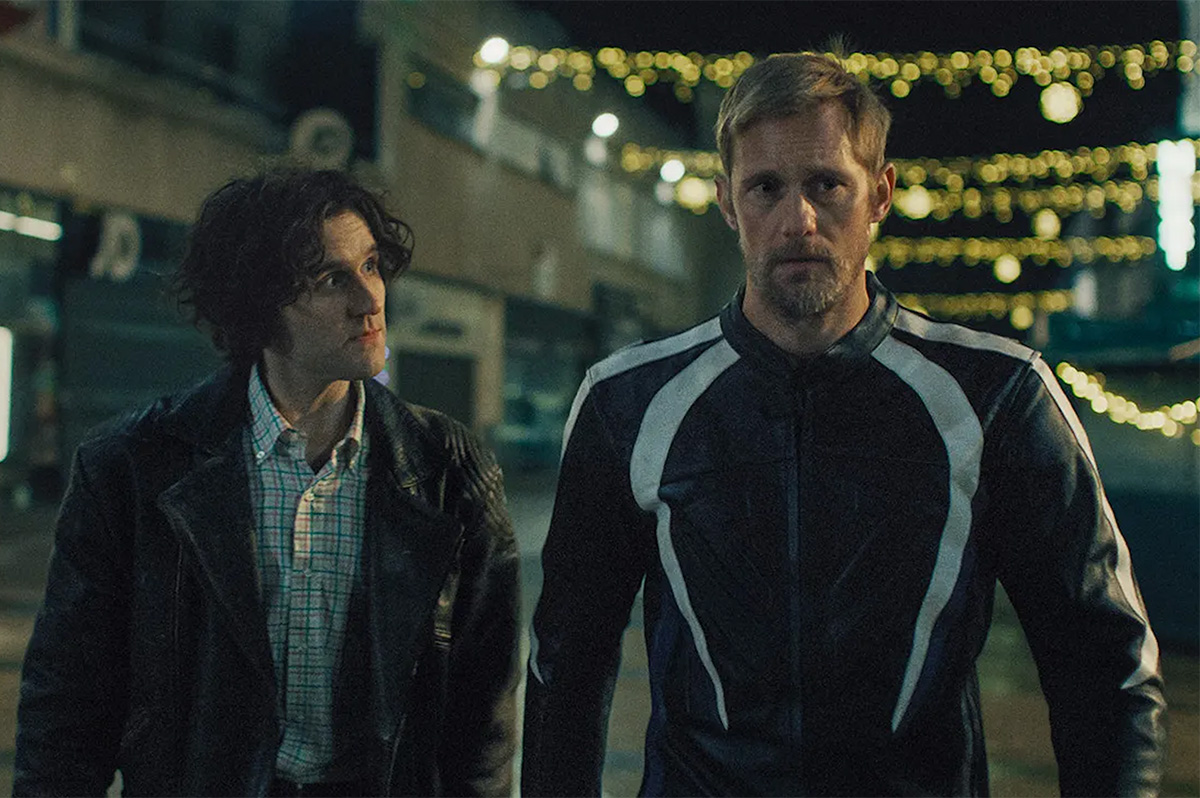
In case you didn’t know, “Pillion” – the title of debut UK filmmaker Harry Lighton’s buzzy gay “fetish rom-com” starring Scandinavian hunk Alexander Skarsgård and “Harry Potter” alumnus Harry Melling – refers to a rear seat on a motorcycle for a passenger, and the person who occupies it is said to be “riding pillion.”
That definition might be useful going into the movie’s story of an introverted gay Londoner who becomes involved with a handsome but icy biker and is introduced to the subculture of Dom/sub relationships, in that it evokes a dynamic that might be said to reflect the one that exists between its two main characters. There is nothing about Lighton’s disarmingly humorous and surprisingly sweet film, however, that seems to imply an interest in offering pat explanations or easy value judgments about the lifestyle it explores, so to think its title is meant as some kind of summation would be a mistake.
It centers on Colin (Melling), a timid parking warden who still lives with his mom and dad (Lesley Sharp and Douglas Hodge) and sings with a barbershop quartet as a hobby. After a gig singing Christmas carols at a gay bar, he catches the eye of sleekly confident Ray (Skarsgård), who gives him his phone number after a brief and thrillingly intimidating interaction. Prompted by his parents, he decides to call, leading to a steamy hookup in a back alley – and eventually, a live-in BDSM situation in which he becomes Ray’s official “sub,” catering to his every need and becoming a member of the gay biker community to which he belongs. It’s all perfectly fine with Colin, who embraces his role with pleasure; but when he begins to long for a deeper connection with the enigmatic and emotionally distant Ray, it triggers a disruption in the dynamic of their relationship, putting it to a test it may not be able to pass.
“Pillion” was already creating a stir before its prize-winning debut at the Cannes Film Festival last May, largely thanks to the highly publicized casting of Skarsgård as the leather-clad leading man in a gay BDSM romance. But near-universal critical acclaim quickly validated the buzz, turning it into one of 2025’s most anticipated movie releases – particularly, of course, for gay audiences, and especially for those who are part of the BDSM community and rarely get the opportunity to be “seen” on the screen as anything other than a lazy stereotype.
Naturally, much of that buzz has been driven by a prurient fervor, fueled by the promise of kinky onscreen sex and rumors of a notorious close-up highlighting the full-frontal assets of a certain Swedish movie star. One of the things that’s remarkable about “Pillion,” however, is that while it certainly doesn’t downplay the overt sexual aspect of the relationship at its center, it doesn’t use them to titillate or shock us. Its plentiful scenes of intimacy are sexy, yes, but they also chart the development of the characters’ bond together, expressing feelings that can only be left unspoken within their agreed-on dynamic. They advance both the story and our awareness of the characters’ psychology, and while they may occasionally provide a jolt for viewers not accustomed to seeing gay fetish sex portrayed explicitly on screen, they successfully capture the joy of the experience instead of making it feel sensationalized or lurid.
In fact, once “Pillion” ends, it’s not the sex (not exclusively, at least) that lingers in our mind; it’s the delicate balance it maintains between tension and ease, detachment and tenderness, rigidity and flow – mirroring the surging passions contained within the strictly regimented order of their power dynamic. It’s the depth of Melling’s film-anchoring performance, in which he undergoes an entire voyage of discovery that emphasizes Colin’s strength, not his timidity, and allows us to relate to him in ways that may surprise us. It’s the authenticity of the relationships between all the characters, from Sharp and Hodge’s doting parents to Scissor Sisters front man Jake Shears (in his film acting debut) as a fellow sub who ignites a spark of jealousy between Colin and Ray; most of all, it’s the way that it allows the story to move, with a slow and methodical rhythm – reflected in the measured strains of Eric Satie’s “Gymnopode No.1” that echo through Oliver Coates’ evocative score – that makes it all feel perfectly natural.
And yes, it’s also the presence of Skarsgård, who subtly (and with wry humor) contrasts tight-lipped alpha stoicism with his flawless male beauty that feels like a force of nature. We don’t know much about Ray, ever, through the dialogue in Lighton’s tersely worded screenplay, but we can draw our own conclusions from the eloquent silence that Skarsgård wraps around the character like a security blanket. Best of all, he never uses his “Dom” role in the film to overshadow Melling – it’s Colin’s story, after all, and Skarsgård’s Ray deploys a tactic of “quiet command” on him throughout without ever stealing his spotlight.
As for the film’s writer/director, Lighton manages perhaps the most delicate balancing act of all. He takes a story (adapted from a novel by Adam Mars-Jones) about someone discovering himself in the BDSM community, who engages in sexual behavior that’s likely out of the comfort zone of many viewers and enters a “romantic” partnership most people would find unacceptable, and turns it into a movie that is all about the complexities of human experience. You may not know much (or want to) about life as a sub in a BDSM partnership, but you know what it feels like to love someone, and to long for love in return; Lighton understands that “Pillion” is a story about that, and he knows how to tell it so that you will understand it, too.
That said, it’s obvious there will be many audiences out there for whom a movie about leather-clad queer fetish sex might simply be a step too far for them to take. Anyone approaching “Pillion” should be aware that, depending on your own level of familiarity – or comfort – with the BDSM lifestyle, your reaction may vary across a spectrum of perspectives; if you’ve been around it, nothing the movie shows you is likely to ruffle your feathers, and if you haven’t, well, only you know your limits.
For us, it’s a film to admire from a promising new queer director, shining a light on an insular culture within the larger rainbow community with intelligence, dignity, and a refreshing lack of the homophobic tropes that so often haunt queer movies, even when they are made by queer filmmakers themselves.
Unfortunately for Americans, while “Pillion” was released in the UK on Nov. 28, we won’t get a chance to see it until Feb. 6. With the buzz now even stronger and the stars in full “promotional” mode on the talk show circuit, we thought it would be a good idea to let you know that the wait might still be a while, but it will be worth it.
After all, as any good Dom can tell you, a pleasure withheld tastes even sweeter when it’s finally given.

What does longing for your child look like? What happens when they resurface in front of you, when that rift was once an immeasurable open sea — a searing pain that silently hollowed you out for decades? For the child wrenched away by circumstance and thrown into the purgatory of always feeling in-between: in between home, in between being a whole person, in between who you could have been and who you are now — what does it mean to become and belong?
In filmmaker Jota Mun’s documentary “Between Goodbyes”, the fragmented yearning for home, family and identity are woven together into a tremendous and at times dream-like contemplation of the self, focused on various family members set adrift by a deceitful international adoption machine.
The story is focused on Mieke Murkes, a queer Korean adoptee who grew up in the rural village of Vaassen in the Netherlands. Shortly after her birth in 1982, she was raised by Willy, a devout evangelical Christian woman. But the story does not begin with Mieke in Vaassen. It begins with Okgyun, her original mother, walking through an ephemeral meadow as she makes her way to a shoreline. This is our first point of loss.
It is important to understand how the stories of Okgyun and Mieke exist. In “Between Goodbyes”, we see a frustrating glimpse into the cultural and political forces that created this separation. Since 1955, 200,000 children have been adopted from South Korea, and just three years ago, several of these adoptees found that their documents had been falsified. Murkes would sift through her own papers in “Between Goodbyes”, noting their dull and rote descriptions of her physical appearance and health. “The paperwork is as if you’re buying a new car,” Murkes says.
Written nearby: “Both parents are unknown,” a falsehood that leaves the family breathless. It is a gut punch.
This March, a South Korean governmental agency admitted that it had violated the rights of adoptees, but an investigation that began in 2022 at the behest of over 350 Korean adoptees has been halted. Whether or not retribution can ever be paid is up in the air, but the reeling grief and complicated self-reckoning many of these adoptees and their families face are rendered and expressed with deep tenderness in Mun’s documentary. “I did not know how to fit the Korean part of me in there,” Murkes said.
When Okgyun was pregnant with Mieke, she was also raising three other daughters: Mijin, Mikyung and Taekyung. The population was booming, and mothers like herself were being shamed for continuing to have children. Considering abortion, Okgyun recounts a midwife who convinced her not to go through with it — that if the child were a boy, she should keep him. If it turned out to be a girl, she could give her away to live “a good life” in the U.S. “Men are always positioned above women,” Okgyun said. “I always hated that.”
After Mieke was born, Okgyun’s mother-in-law told her to give her away. “She was gone before I saw her face,” Okgyun said. “I let her go.” Her guilt tightens her throat, trembles in her voice. “I dreamed of Mieke a lot. I can’t tell you how many times,” Okgyun said. “Dreaming and forgetting, dreaming, and forgetting. The thought that kept me going is that one day I can find Mieke.”
What ensued was a several years-long search. Kwangho, Mieke’s original father, pleaded with an adoption agency for any leads about Mieke. They denied him several times and his desperation only grew. “I had to find her to be at peace before I die,” he said.
Meanwhile, Mieke’s own grief and confusion were compounding. When she was beginning to discover her queerness, she was deeply ingrained in local religious spaces. What made her feel free, the church treated as an aberration — as behavior that resulted from loss.
When she would eventually meet her original family, they, too, had trouble processing her queer identity and masculine presentation. To them, queerness was “acquired” from being raised in a foreign land. With time, they grew to embrace Mieke and her partner, Marit, even as misunderstandings arose. Of this, Mieke’s conflictedness is explored. Gay rights are more advanced and accepted in the Netherlands than in South Korea, but this does not mean contending with her queerness would have been easy with her adoptive mother, Willy. “It probably would have disappointed her a lot,” Mieke tearfully revealed.
Mieke’s stepping in between knowing and unknowing is reminiscent of Okgyun’s dreaming and forgetting — their grief and confusion move within them, replicating themselves over and over again. “Between Goodbyes” dives deeply into this in order to offer a portrait of healing: of its complications and the necessity of community support to achieve this.
Mun discusses the film with the Los Angeles Blade, diving into how reunification between adoptees and original family members is, in many ways, made nearly impossible by factors like language and cultural barriers enforced and held tightly in place by the international adoption system. This film illustrates a break in this narrative and the mighty efforts behind it all.
A broadcast version of “Between Goodbyes” is now available to stream on PBS. See below for more information.
Can you tell me about the inception of making “Between Goodbyes”? Have you always wanted to tell a story about international Korean adoption from a queer perspective?
As a queer Korean adoptee myself, [there are] so many intersections that I haven’t quite seen on screen before. So I was always really excited about making something about my community. And then I’d say, in 2017, is around when I started getting closer to zeroing in on the idea. I think part of it was through befriending Mieke and hearing her parents’ story. Hearing about their efforts really blew my mind.
So much of the standard narrative is that adoptees initiate the search. So even before meeting [Okgyun and Kwangho], it just felt like it spoke so loudly of not only their character, but a piece of the puzzle that I had never considered — that they could be longing for us. And I think as an adoptee, you always wonder what [your original parents] would think. So it’s very noticeable that we almost don’t ever hear from them directly. Even in narrative stories of adoption, they’re usually deleted, or they’re written in a really flat way that feels like they’re serving the plot. I’ve never seen a depiction of birth mothers in particular who are questioning their own circumstances or feel angry about it.
There’s a lot of nuance given to all of the different people that we see in the story. The pain is layered and deep, and we don’t just view it from one perspective. What was it like having to portray this hurt, when many adoption stories typically focus solely on the adoptee’s emotional and personal journey?
It’s so unique through each lens, even though it’s the same pain. Like her sisters — of course, it’s going to affect them. Even if she never said anything, they must have felt it. It just ripples out to everyone and keeps expanding.
Originally, it was focused on Mieke, because that’s who I had the most access to, and she’s the closest to me in terms of general identity markers. So in my mind, I felt more confident that I could tell her story in a nuanced way. But what about Okgyun? I was hitting a similar barrier of communication that Mieke had hit. That’s part of why our main producer, Zoe Sua Cho, was so essential in conveying more about Okygun and the original family’s side of the story.
When I was in the early stages of developing the film, there was a quote that I felt was really inspirational: “In our hurting, we did not realize that we were stolen from each other” (by SN Désirée Cha from Outsiders Within Writing on Transracial Adoption.) The same quote came back to me in the edit and helped us find a narrative structure that went beyond just one person’s perspective.
What if the main character is the collective trauma, a singular event that causes the family to splinter and suffer across decades? I wanted to explore how tempting it is in these moments of righteous anger at systemic problems to end up fighting with each other. I feel like they both had to mourn something that was so much bigger than any one family. Mieke’s adoption affected so many people that I almost wanted that to be the main character. How do we not get lost in that pain and still try to come back together? It’s too much to carry alone.
So the main character is not necessarily one person, but the issue that you’re trying to tackle throughout the story. It also makes me think about how the documentary itself, or the making of it, also participates in this community healing that I feel like was the focus of “Between Goodbyes”.
I hope it’s an important layer. Suffice to say I think I always deflect to name a singular main character. I wanted to show everyone’s point of view while of course highlighting especially Okgyun and Mieke.
What else can you share about your approach to filmmaking?
You know, I was on this wonderful panel earlier this year, hosted by A-DOC, and I kind of surprised myself in preparing for it. I realized, actually, I have a lot of strong beliefs on filmmaking ethics that I hope come through in the film. For example, I reject the genius artist myth. The fantasy that if an artist is talented enough, they get permission to treat everyone around them terribly. That exploitation and squeezing things out of people is the best way to make great art.
Instead, I want to believe that the sensitivity, the care, and emotional work I poured in is going to come shining through in the film. And I do think that’s part of why we witnessed so many intensely vulnerable moments that I couldn’t have predicted.
This emotional connection to the film is also, visually, represented in artistic and inventive ways. There are sequences interspersed throughout that feel dream-like and cinematic. Creatively, what was it like to structure and craft how you wanted those scenes to be, the weight that they carried, and why you wanted to represent them in that way?
Aw, thanks for saying so! I was clear from the beginning that I wanted certain moments in the film to look as cinematic and epically life-changing as they feel in real life. Because visually, sometimes these moments of heartbreak can look rather dull. The deep heartbreak of a farewell at the airport. What does it look like? It looks like two people hugging in a very normal-looking terminal. But that’s not what it feels like. It feels larger than life. So to me, every single one of the art [scenes] has a very literal symbolism in my mind.
I really enjoy the complexity given to the family, both through the artistic symbolism and through the different angles we get to view them in. When it comes to Mieke’s queer identity, there are varying levels of acceptance and also tension that co-exist. One of her sisters, Mikyung, skirts around terms and labels, instead saying Mieke is “like that,” and “I don’t know anyone like that.” There was this feeling that queerness is learned or acquired elsewhere — that Mieke “wouldn’t have turned out like that” if she had grown up with her original family in Korea.
I can’t be sure what they were implying but you know, I definitely didn’t want to fall into a common trope of seeing Western values as being so liberal and accepting and framing all other cultures as homophobic. I want to be clear that there is a queer community in Seoul. It’s not the same as Amsterdam, of course, but it does exist.
That’s part of why it was important for me to include Mieke mentioned what she thinks her Dutch mom would have thought — just to clarify that homophobes are everywhere. There are plenty of them here in the West as well. Mieke’s Dutch parents were Evangelist Christians. So it’s not like everyone in the West is free to be a lesbian, you know?
Another moment that struck me in the film was a moment where we, as the audience, get to see you clearly. In this scene, we see you and Mieke on a rooftop, and you’re consoling her as she’s trying to prepare for a difficult conversation with her original mother, Okgyun. Did you have to find a balance in terms of being the director of this film and being Mieke’s friend?
It was really important to me to show friendship and how much that can help you along the journey. You think that for her to emotionally process things, it would have to be with her mom. But that rooftop conversation felt so transformative in itself. And then what ended up being the kind of mirror scene to that was Okgyun talking to Ruth [a fellow original mother]. She needed a buddy, too. How many times in life are we like: the opposing party doesn’t need to get it, but if my friend just could — that would give me so much relief and patience to enter the actual conversation with the person I’m upset with.
Being so personally close to Mieke and her family meant that my film was about all people I loved and cared about. I think the documentary field comes from such a long history of an anthropological approach. It’s like, “I’ve helicoptered in, and I just met you, but I’m the expert artist.” I wish the ethos were the opposite; we need to care about everyone, from the participants to the crew. I don’t want the blood, sweat, and tears to come through on the screen. I hope that watching it makes people feel cloaked in tenderness and care.
I was so worried about everyone, probably too much. It’s such a weird thing to ask people to do, to be in a film, so I took that with a lot of responsibility. Be aware of the impact you’re having. I am having an effect on this family’s life. I almost wanted to be like: “Forget my art project.” This is about the rest of their lives as a family, and that’s more important. So it became a light on my path, trying to make decisions as best I could to have a positive impact on their relationship.
It almost made me question my ethics in a different direction. “Am I intervening too much?” And that’s a strange thing: I have to admit I exist. I’m not a fly on the wall. And I think that’s why the conversation on the roof was really the most vulnerable for me, because I was showing myself. I’ve actually been here the whole time, cheering them on or trying to diffuse tension. I set out to make a film about how hard it is to stay in reunion, but now I’ve realized I’ll be heartbroken if their reunion doesn’t last. So in many ways the film was really just a vehicle for my attempt at keeping us all connected across so many distances, and that’s my own emotional journey or connection to their story.
Mun plans to release the full-length film in 2026, along with deleted scenes and additional footage. Up-to-date information can be found on the film’s Instagram page.
Movies
A bad romance is brought to light in ‘300 Letters’
All is not as it seems on social media in gay ‘anti-romcom’

We’ve all known them. We’ve all watched those couples on our “friends” feed who seem to live a perfect life together; young, attractive, and devoted to each other, they present an aspirational image on social media, documenting their romance for friends, followers, and all the world to see. We can’t help but envy them, but at the same time, we can’t help feeling like it’s all just a little too good to be true – and inevitably, our instinct is eventually proven right by an abrupt and messy breakup that ends up being aired just as publicly as the rest of their relationship.
That’s the kind of couple that occupies the center of “300 Letters,” a self-described gay “anti-romcom” from Argentine filmmaker Lucas Santa Ana (“Memories of a Teenager”), which garnered acclaim on the festival circuit both in its native country and in the U.S. earlier this year. Now available for home viewing via Prime Video and other VOD platforms, it might just be the perfect alternative if you need a counterbalance to all the sugary sweet holiday romances that tend to dominate the seasonal content offerings.
It’s the saga of the one-year romance between Jero (Cristian Mariani) and Tom (Gastón Frías), an “opposites attract” couple who meet (on Grindr, of course), have great sex, and become a couple despite the differences in their status (Jero is a “masc”-presenting cryptocurrency bro, Tom a struggling queer radical poet) and their outlook on life; they move in together, building a relationship that – thanks to Jero’s popular social media profile – soon has its own fandom. Then, on their first anniversary together, Jero comes home from his Crossfit class with plans for the big celebration – only to find that Tom has packed up and moved out, ending their relationship and leaving behind only a box of letters as an explanation.
Jero, blindsided and devastated, is at first resistant to the letters, but – at the urging of his best friend Esteban (Bruno Giganti), who believes it will help him move on – he decides to read them; the story they tell reveals that his couplehood with Tom was never as he had perceived it to be. Built on sex and maintained through performative routine, there had been an underlying agenda hidden beneath it from the beginning. As he continues the painfully eye-opening process of learning the truth, he is forced to question his own honesty in the relationship – all while holding on to an attachment that may have been a performance all along.
We’ll admit it sounds like a gimmicky premise, and also kind of a downer, but there’s a sensibility behind “300 Letters” that somehow overcomes those pitfalls. Thanks to the conceit of learning the story through letters – sometimes out of order – we are gradually coaxed (along with Jero) toward our own conclusions and epiphanies as the details (and layers of complexity) become more clearly defined; it keeps us engaged through this gradual reveal, allowing time for the uncomfortable truths to sink in, and maintains a subtle sense of humor to keep the tone from being bogged down by melancholy.
According to Santa Ana, who also co-wrote the film with Gustavo Cabaña, all of that is by design.
“I love romantic comedies and breakup movies, and I wanted to combine them while also talking about something that interests me within the LGBT world,” the filmmaker says of his movie. “We always talk about the discrimination we suffer from outsiders, but we rarely think about the discrimination we inflict on ourselves due to the prejudices we carry. In ‘300 Letters,’ I wanted to explore this topic with a fun and relaxed perspective.”
It pays off better than you might expect. Thanks to the carefully balanced screenplay and the performances of its two leading men, it manages to point out the mismatched couple’s faults, flaws, and foibles, while also making them both relatable. In the end, we definitely get the message: the assumptions we have about other people shape our perceptions of them in ways to which we are usually blind, and the prejudices we carry can become self-fulfilling prophecies when we only see what we are looking for. More than that, it’s a refreshingly candid and mature exploration of relationships – and yes, gay relationships in particular – which reminds us that every love affair has meaning and value, and that even a failed one is worth having if it helps you learn how to do better next time.
On the flip side, it’s easy to imagine some viewers finding both characters tiresome. Jero is charming, and he’s definitely sexy, but he’s undeniably mired in a comfortably conventional queerness that makes us more inclined to sympathize with Tom – who is, himself, perhaps equally as judgmental in his assumptions about others, and who seemingly has no qualms about gaslighting his partner, but somehow still feels more “authentic” than Jero.
Fortunately, “300 Letters” is not the kind of movie that makes us choose between them. Instead, it invites us to see parts of ourselves in each of them, and in the end is really more about the “culture of presentation” – the obsession with projecting an appealing image, of seeking private validation through public display – than it is about holding up either of its protagonists for judgment. Instead, it leaves us to contemplate our own relationships in the light of self-awareness, never pulling the emotional punch that comes with loss and the grieving of a relationship, but somehow letting us see the wisdom that awaits us on the other side of it.
In the starring roles, Mariani and Frías are equally charismatic in their own distinctive way, capturing a chemistry that both “clicks” and doesn’t at the same time; Giganti also delivers a presence, subtly conveying his character’s unspoken role as the third point in a triangular relationship, There’s a deep complexity behind these characters that goes largely unspoken, but which emerges in their performances all the same; and if, in the end, the balance of our sympathies may have shifted more toward one of them than the other, that’s OK.
In Santa Ana’s deceptively breezy post-mortem of a break-up, that’s just how relationships go.

